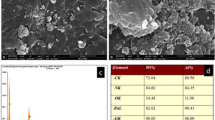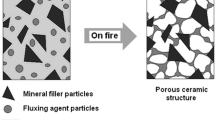Abstract
Heat conductivity, curing rate and fatigue crack growth properties of carbon black-filled styrene butadiene rubber (SBR)/butadiene rubber (BR) blend that is frequently used in passenger car tire treads were simultaneously improved by a hybrid filler system of carbon black, high dispersible precipitated silica, modified layered silicate and ultra-light mixed filler of alumina and aluminum sulfate. An optimum formulation was obtained and a study of mechanisms governing composite properties has been performed according to the filler variables through the designing of experiments and the regression and statistical analysis and with the aid of composite characterization techniques such as dynamic mechanical analysis (DMA) and FE-SEM/EDX. Alumina could improve thermal conductivity, DeMatia crack growth, and the tensile strength of the rubber composite, along with relative maintenance of hardness and modulus. The effects of statistically significant interactions between silica and alumina on the abrasion behavior and thermal conductivity were observed, which was attributed to the presence of the silane coupling agent and the effect of modifying the alumina surface with the ethoxysilanes groups. The partial substitution of carbon black by high dispersible silica resulted in an increase in thermal diffusion coefficient, the improvement of heat buildup, resilience and DeMatia crack growth, and relative maintaining of tensile properties as well as a slight loss in abrasion and aging behavior of the tire tread composite. Through the increase of thermal diffusivity coefficient and a slightly improvement in the aging behavior, modified layered silicate (organoclay) caused a significant reduction in the optimum curing time of the tire tread composite. Some evidence has been provided for the interactions between modified layered silicate and silane coupling agent. The improvement in crack growth and thermal conductivity of the elastomer composite was attributed to smaller interparticle distances of hybrid filler system compared to those of carbon black filler system.











Similar content being viewed by others
References
Guo B, Tang Z, Zhang L (2016) Transport performance in novel elastomer nanocomposites: mechanism, design and control. Prog Polym Sci 61:29–66
Li A, Zhang C, Zhang YF (2017) Thermal conductivity of graphene-polymer composites: mechanisms, properties, and applications. Polymers 9:437–454
Tsekmes I, Kochetov R, Morshuis P, Smit J (2013) Thermal conductivity of polymeric composites: a review. In: IEEE International Conference on Solid Dielectrics (ICSD). Paper presented at 2013
Guo Y, Ruan K, Shi X, Yang X, Gu J (2020) Factors affecting thermal conductivities of the polymers and polymer composites: a review. Compos Sci Technol 193:108–134
Wypych G (2000) Handbook of fillers, 2nd edn. ChemTec Publishing, Toronto
Li Y, Han B, Liu L, Zhang F, Zhang L, Wen S, Shen J (2013) Surface modification of silica by two-step method and properties of solution styrene butadiene rubber (SSBR) nanocomposites filled with modified silica. Compos Sci Technol 88:69–75
Bhattacharyya S, Dasgupta S, Londa V, Mukhopadhyay R (2019) Influence of highly dispersible silica filler on the physical properties, tearing energy and abrasion of tire tread compound. J Appl Polym Sci 136:47560–47572
Wang MJ (1998) Effect of polymer-filler and filler-filler interactions on dynamic properties of filled vulcanizates. Rubber Chem Technol 71:520–589
Wagner MP (1976) Reinforcing silicas and silicates. Rubber Chem Technol 49:703–774
Byers JT (2002) Fillers for balancing passenger tire tread properties. Rubber Chem Technol 75:527–548
Galimberti M, Agnelli S, Cipolletti V (2017) In: Thomas S, Maria HJ (eds) Progress in rubber nanocomposites, Woodhead Publishing, UK
Rooj S, Das A, Morozov IA, Stöckelhuber KW, Stocek R, Heinrich G (2013) Influence of expanded clay on the microstructure and fatigue crack growth behavior of carbon black filled NR composites. Compos Sci Technol 76:61–68
Kim WS, Lee DH, Kim IJ, Son MJ, Kim W (2009) SBR/organoclay nanocomposites for the application on tire tread compounds. Macromol Res 17:776–784
Arroyo M, López-Manchado M, Herrero B (2003) Organo-montmorillonite as substitute of carbon black in natural rubber compounds. Polymer 44:2447–2453
Mohan TP, Kuriakose J, Kanny K (2011) Effect of nanoclay reinforcement on structure, thermal and mechanical properties of natural rubber–styrene butadine rubber (NR–SBR). J Ind Eng Chem 17:264–270
Li Z, Chen H, Zhu Z, Zhang Y (2011) Study on thermally conductive ESBR vulcanizates. Polym Bull 67:1091–1104
Wang ZH, Lu YL, Liu J, Dang ZM, Zhang LQ, Wang W (2011) Preparation of nanoalumina/EPDM composites with good performance in thermal conductivity and mechanical properties. Polym Adv Technol 22:2302–2310
Roy K, Jatejarungwong C, Potiyaraj P (2018) Development of highly reinforced maleated natural rubber nanocomposites based on sol-gel-derived nano alumina. J Appl Polym Sci 135:46248–46257
Teena T, Ayswarya EP, Eby TT (2013) Nano alumina as reinforcement in natural rubber composites. Int J Innov Res Sci Eng Technol 2:2365–2370
Ten Brinke J, Debnath S, Reuvekamp LA, Noordermeer JW (2003) Mechanistic aspects of the role of coupling agents in silica–rubber composites. Compos Sci Technol 63:1165–1174
Gabriel CFS, Gabino AAP, de Sousa AMF, Furtado CRG, Nunes RCR (2019) Tire tread rubber compounds with ternary system filler based on carbon black, silica, and metakaolin: contribution of silica/metakaolin content on the final properties. J Elast Plas 51:712–726
Ghoreishy MHR, Abbassi-Sourki F (2017) The molecular structure of SBR and filler type effects on thermal diffusivity of SBR/BR compounds used in tire tread. (in persian) Iran. J Polym Sci Technol 30:139–149
Pan Q, Wang B, Chen Z, Zhao J (2013) Reinforcement and antioxidation effects of antioxidant functionalized silica in styrene–butadiene rubber. Mater Des 50:558–565
Limrungruengrat S, Chaikittiratana A, Pornpeerakeat S, Chantrasmi T (2018) Finite element analysis for evaluation of cure level in a large rubber part. Mater Today Proc 5:9336–9343
Hands D (1977) The thermal transport properties of polymers. Rubber Chem Technol 50:480–522
Proust M (2005) Design of experiments. SAS Institute Inc, Cary
Derringer GC (1988) Statistical methods in rubber research and development. Rubber Chem Technol 61:377–421
Ghasemi I, Karrabi M, Mohammadi M, Azizi H (2010) Evaluating the effect of processing conditions and organoclay content on the properties of styrene-butadiene rubber/organoclay nanocomposites by response surface methodology. Exp Polym Lett 4:62–70
Balachandran M, Bhagwan SS, Muraleekrishnan R (2011) Modeling and optimizing properties of nanoclay–nitrile rubber composites using Box-Behnken Design. Rubber Chem Technol 84:455–473
Choi SS, Choi SJ (2006) Influence of silane coupling agent content on crosslink type and density of silica-filled natural rubber vulcanizates. Bull Korean Soc 27:1473–1476
Ganter M, Gronski W, Reichert P, Mülhaupt R (2001) Rubber nanocomposites: morphology and mechanical properties of BR and SBR vulcanizates reinforced by organophilic layered silicate. Rubber Chem Technol 74:221–235
Bhattacharya M, Maiti M, Bhowmick AK (2008) Influence of different nanofillers and their methods on the properties of natural rubber nanocomposites. Rubber Chem Technol 81:782–808
Custodero E, Tardivat JC (1999) Diene rubber composition based on alumina as reinforcing filler and it’s use for the manufacture of a tire. Patent US005900449A
Gherib S, Chazeau L, Pelletier JM, Satha H (2010) Influence of the filler type on the rupture behavior of filled elastomers. J Appl Polym Sci 118:435–445
Jeon GS, Han MH, Seo G (1999) Enhancing adhesion properties between rubber compound and brass-plated steel cord by incorporating silica into rubber. J Adhesion Sci Technol 13:153–168
Datta RN (2003) Review on heat and reversion resistance compounding. Prog Rubber Plast Re 19:143–170
Auer EE, Doak KW, Schaffner IJ (1958) Factors affecting laboratory cut-growth resistance of cold SBR tread stocks. Rubber Chem Technol 31:185–201
Grosch K, Harwood JAC, Payne AR (1966) Breaking energy of rubbers. Nature 212:497
Dizon ES, Hicks AE, Chirico VE (1973) The effect of carbon black parameters on the fatigue life of filled rubber compounds. Rubber Chem Technol 47:231–249
Robertson CG, Lin CJ, Rackaitis M, Roland CM (2008) Influence of particle size and polymer–filler coupling on viscoelastic glass transition of particle-reinforced polymers. Macromolecules 41:2727–2731
Tse MF, Mcelrath KO, Wang HC (2002) Relating De Mattia cut growth to network structure of crosslinked elastomers. Polym Eng Sci 42:1210–1219
Mohanty TR, Bhandari V, Chandra AK, Chattopadhyay PK, Chattopadhyay S (2013) Role of calcium stearate as a dispersion promoter for new generation carbon black-organoclay based rubber nanocomposites for tyre application. Polym Compos 34:214–224
Kienle RN, Dizon ES (1971) Tread wear and wet skid resistance of butadiene-styrene elastomers. Rubber Chem Technol 44:996–1014
Wu G (2016) The mechanisms of rubber abrasion. Phd thesis, Queen Mary University of London
Rattanasom N, Saowapark T, Deeprasertkul C (2007) Reinforcement of natural rubber with silica/carbon black hybrid filler. Polym Test 26:369–377
Fukahori Y, Yamazaki H (1995) Mechanism of rubber abrasion part 3: how is friction linked to fracture in rubber abrasion? Wear 188:19–26
Shiva M, Hadadi AH, Nakhaei A, Varasteh H (2015) Study of abrasion of rubber materials by experimental design, response surface and artificial neural network nodeling (in persian) lran. J Polym Sci Technol 28:197–209
Ma JH, Zhao SH, Zhang LQ, Wu YP (2013) Comparison of structure and properties of two styrene–butadiene rubbers filled with carbon black, carbon-silica dual phase filler, and silica. Rubber Chem Technol 86:664–678
Han Z, Wood JW, Herman H, Zhang C, Stevens GC (2008) Thermal properties of composites filled with different fillers. In: Conference Record of the 2008 IEEE International Symposium on Electrical Insulation, IEEE, pp. 497–501
Evans W, Prasher R, Fish J, Meakin P, Phelan P, Keblinski P (2008) Effect of aggregation and interfacial thermal resistance on thermal conductivity of nanocomposites and colloidal nanofluids. Int J Heat Mass Transf 51:1431–1438
Kochetov R, Korobko AV, Andritsch T, Morshuis PHF, Picken SJ, Smit JJ (2011) Modelling of the thermal conductivity in polymer nanocomposites and the impact of the interface between filler and matrix. J Phys D Appl Phys 44:395–401
Roy M, Nelson JK, MacCrone RK, Schadler LS, Reed CW, Keefe R, Zenger W (2005) Polymer nanocomposite dielectrics-the role of the interface. IEEE T Dielect El In 12:629–643
Sarkawi SS, Dierkes WK, Noordermeer JWM (2014) Elucidation of filler-to-filler and filler-to-rubber interactions in silica-reinforced natural rubber by TEM network visualization. Eur Polym J 54:118–127
Krajnik P, Kopac J, Sluga A (2005) Design of grinding factors based on response surface methodology. J Mater Proc Technol 162–163:629–636
Acknowledgements
The authors of this article are grateful for financial support and services from Kavir Tire Company.
Author information
Authors and Affiliations
Corresponding author
Electronic supplementary material
Below is the link to the electronic supplementary material.
Rights and permissions
About this article
Cite this article
Shiva, M., Akhtari, S.S. & Shayesteh, M. Effect of mineral fillers on physico-mechanical properties and heat conductivity of carbon black-filled SBR/butadiene rubber composite. Iran Polym J 29, 957–974 (2020). https://doi.org/10.1007/s13726-020-00854-0
Received:
Accepted:
Published:
Issue Date:
DOI: https://doi.org/10.1007/s13726-020-00854-0




